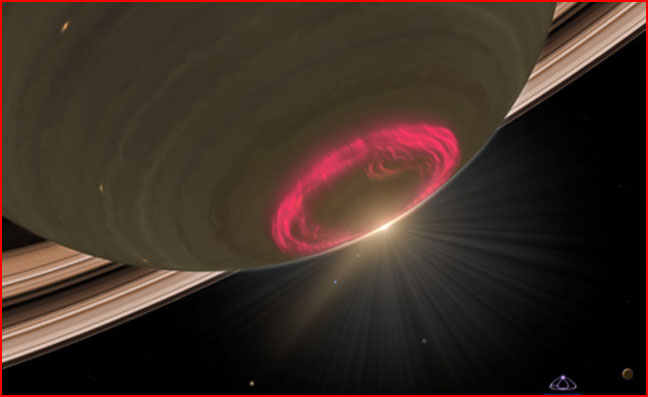
home •
about •
essential guide •
picture of the day •
thunderblogs •
news •
multimedia •
predictions •
products •
get involved •
contact
picture of the day archive subject index
This image of Saturn’s south polar aurora is an artistic rendition, converting ultraviolet data into the nearest
visible color. CREDIT: NASA, ESA and A. Schaller, STScI-PRC05-06b
Mar 13, 2008
The Electrical Heating of SaturnAstronomers have recently discovered that their earlier “explanation” for anomalous heating of Saturn’s upper atmosphere doesn’t work.
The temperatures of the upper atmospheres of giant planets have long presented a conundrum to astronomers. They are hotter than can be explained by absorbed sunlight, and other attempts to explain the temperature anomalies in mechanical terms have met with failure. The electrical theorists suggest that such problems will persist as long as astronomers ignore electricity.
Since the giant planets display spectacular auroras at their polar regions, scientists believed that these auroras generated heat that was somehow directed toward the planets' equators. On Earth, a similar mechanism (magnetic energy in the magnetosphere) is claimed to drive the Northern Lights and heat the upper atmosphere.
But according to a report last month in the journal Nature, the proposed mechanism would actually COOL Saturn's upper atmosphere at the lower latitudes. Thus scientists must deal with an energetic meteorological phenomenon for which they have no ready explanation. "This unexplained 'energy crisis' represents a major gap in our understanding of these planets' atmospheres," the scientists write.
"We need to re-examine our basic assumptions about planetary atmospheres and what causes the observed heating," said study team member Alan Aylward of the University College London.
Proponents of the Electric Universe welcome this candor, though it does not go far enough. The "basic assumption" that has directed the space sciences for nearly a century is the belief that space is electrically inert. Most astronomers and meteorologists still do not realize what has already been demonstrated by recent discoveries of the Earth-Sun connection: charge exchange is continuous, and the auroras are just one effect of the ongoing electrical transactions. The planetary theater is, in fact, filled with electrical circuits across the conducting plasma medium.
It is the electric model of the Sun that will enable us to understand the highly energetic meteorological phenomena we see on many planets in our solar system. In this view, electrical storms on planets – including Earth -- are fed by interplanetary currents focused largely on the Sun. The increases in solar output, together with the incoming currents directly intercepted by planets, can charge up the planetary ionospheres – the outcome being “anomalous” heating of the upper atmospheres.
Once we see the issue in electrical terms, it becomes clear that scientific inquiry on other questions will continue to be misguided until the electrical component is acknowledged. It is well past time for scientists to revisit the debate on “global warming” on Earth, for example, since virtually all published articles in the debate have ignored the crucial role of the electric Sun.
__________________________________________________________________Please visit our new "Thunderblog" page
Through the initiative of managing editor Dave Smith, we’ve begun the launch of a new
page called Thunderblog. Timely presentations of fact and opinion, with emphasis on
new discoveries and the explanatory power of the Electric Universe."The Electric Sky and The Electric Universe available now!

|
|

|
EXECUTIVE EDITORS:
David Talbott, Wallace Thornhill
MANAGING EDITORS:
Steve Smith, Mel Acheson
CONTRIBUTING EDITORS: Michael Armstrong, Dwardu Cardona,
Ev Cochrane,
C.J. Ransom, Don Scott, Rens van der Sluijs, Ian Tresman
WEBMASTER: Brian Talbott
Copyright 2007: thunderbolts.info
![]()
home •
thunderblogs •
forum •
picture of the day •
resources •
team •
updates •
contact us

